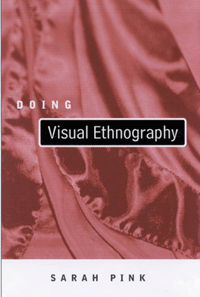

![]()
![]()

Pink's book looks at one type of visual analysis: visual ethnography, which is ethnographic research incorporating photography, video, or hypermedia. The book is presented in three parts. Part 1 situates ethnographic images, and ethnography itself, in a theoretical context and discusses ethical issues. Part 2 includes a chapter each on photography and video in ethnographic research and a chapter on the thorny issues of interpretation. Part 3 discusses the presentation of visual research, with chapters on images in printed text, videos, and hypertext.
Pink divides ethnography into two camps. Scientific-realist ethnography seeks 'the' truth. In contrast, reflexive ethnography asserts there is no objective truth. Academic cultures (visual, social, etc.) vary substantially from the cultures of ethnographic informants. Thus, reflexive research always explicitly considers the academic's frameworks, to make clear that a researcher's interpretation of informants' interpretations are just one form of sense-making. To Pink, who draws on ideas of ethnography as fiction, the scientific-realist approach represents an out-moded style of thinking. Her discussion of scientific-realist visual research serves as a straw person, or a foil to show the strengths of a reflexive approach. (Nevertheless, Pink points out that some images within a reflexive ethnography can serve in a 'documentary' or a 'realist' mode.)
Pink's agenda is ambitious. She sets out to open up visual ethnography to alternative modes of thought. As Pink puts it, researchers should not attach 'the visual to existing methodological principles and analytical frames' but should create new frameworks and methods, 'abandoning the possibility of a purely objective social science and rejecting the idea that the written word is essentially a superior medium of ethnographic representation' (p. 4). Objective research may be decimated by the end of the book, but the written word is not. Despite the predominance of the visual in Pink's discussion, and her score of illustrations, Pink is limited by the requirements of a printed book. She has to put forward her argument in a linear, textual form. Though she discusses a good range of studies using visual images, it is sometimes hard to 'see' her points, as her written descriptions cannot do justice to the original, visual versions. (Readers will want to look up many studies Pink cites.) This proves Pink's assertion of a difference between written and visual knowledge. Pink, however, does not wish to abandon writing altogether. As she puts it in her 'After-word', 'words are good to communicate with' (p. 176).
A key strength of Pink's book is her continual discussion of research ethics, especially the rights of research subjects. To Pink, the only ethically acceptable ethnography involves informants as active participants in the research. She highlights the importance of on-going discussions with informants, obtaining their informed consent for research and eventual publication, and of 'giving something back' to the communities who provide the fodder for ethnographic scholarship. She also discusses the ethics of publication, given that neither researchers nor informants can control how published materials are used or interpreted. Researchers must, therefore, take care that their work cannot harm informants. (She points out, however, that even the most carefully prepared publications can be interpreted by receivers such as students in ways that support racist or other untoward attitudes.)
Of the three sole-authored books on visual methods, Pinks is the thinnest, both literally and figuratively. Banks and Rose, while broadly agreeing with Pink's preference for reflexive work, cover a wider spectrum of visual theories and methodologies. Pink's book is at once narrow and amorphous. On the one hand, Pink seems to value only reflexive or 'innovative' work. Other styles of social thought are not covered or are quickly dismissed. On the other hand, since Pink argues that visual meanings are arbitrary, she seems open to an arbitrary range of techniques. She does not offer specific advice, instead suggesting that researchers tailor their work to local conditions. Pink states explicitly that she is not 'prescribing "how to" do "visual research".' Instead, she says, 'I draw from my own and other ethnographers' experiences of using images in research and representation to present a range of examples and possibilities. These are intended as a basis, or even point of contrast, from which new practices may be developed' (p. 4). While Pink covers interesting territory, she does not set out, in any concrete sense, these new practices. This task is left to the reader.
I recommend this book to postgraduate students who are grappling with the issues Pink discusses and who will follow up on the literature she provides as exemplars. The book does not offer enough scope or background for beginners, failing to cover a range of approaches. Its theoretical sections assume a level of understanding that will be absent from many undergraduates. Undergraduates may also find much of Pink's advice vague or amorphous. On the other hand, experts may find some of Pink's advice quite basic. In the end, however, Pink has put forth many interesting issues which bear both thought and discussion.
Victoria Alexander
University of Surrey